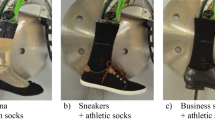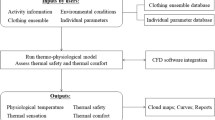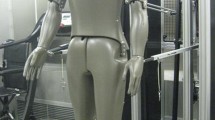Abstract
The convective and radiative heat transfer coefficients of clothing are important parameters for human thermoregulation and comfort models. Many researchers have studied convective and radiative heat transfer coefficients of the naked human body. However, there is limited information on convective and radiative heat transfer coefficients for the clothed human body. Therefore, this study aims to confirm whether the convective and radiative heat transfer coefficients vary with different clothing ensembles in addition to clarifying how the difference in clothing heat transfer coefficients affects the prediction of thermal comfort index, such as the predicted mean vote (PMV) index. The convective and radiative heat transfer coefficients for eight sets of clothing ensembles were measured through a manikin experiment. The results demonstrated that (1) the largest difference between convective heat transfer coefficients for various clothing ensembles was 32%, and (2) PMV values differed between the clothing ensembles with the largest value being approximately 0.2, which corresponds nearly 1 °C change in the indoor temperature. Therefore, it is necessary to consider the actual clothing convective heat transfer coefficient for the precise prediction of thermal comfort.








Similar content being viewed by others
References
Arens E, Zhang H, Pasut W, et al (2011) Thermal comfort and perceived air quality of a PEC system. In: Proceedings of Indoor Air 2011. June 5-10, Austin, TX
ASHRAE (2017) Chapter 9:Thermal comfort. In: ASHRAE handbook Fundamentals. pp 9.1-9.30
Bechert D, Bruse M, Hage W, et al (1997) Biological surfaces and their technological application—laboratory and flight experiments on drag reduction and separation control. In: 28th Fluid Dynamics Conference. American Institute of Aeronautics and Astronautics, Reston, Virigina, pp 505–507
Ben Shabat Y, Shitzer A (2012) Facial convective heat exchange coefficients in cold and windy environments estimated from human experiments. Int J Biometeorol 56:639–651. https://doi.org/10.1007/s00484-011-0463-0
Çengel YA, Ghajar AJ (2019) External forced convection. In: Heat and Mass Transfer: Fundamentals and Applications. McGraw-Hill Education, pp 424–472
Ciesielska-Wrobel I, De Mey G, Van Langenhove L (2016) Dry heat transfer from the skin surface into textiles: subjective and objective measurement of thermal haptic perception of textiles—preliminary studies. J Text Inst 107:445–455. https://doi.org/10.1080/00405000.2015.1034938
Danielsson U (1992) Convection in clothing air layers. In: Proceedings of The Fifth International Conference on Environmental Ergonomics. Maastricht, The Netherlands, pp 70–71
De Dear RJ, Arens E, Hui Z, Oguro M (1997) Convective and radiative heat transfer coefficients for individual human body segments. Int J Biometeorol 40:141–156. https://doi.org/10.1007/s004840050035
De Freitas CR, Grigorieva EA (2015) A comprehensive catalogue and classification of human thermal climate indices. Int J Biometeorol 59:109–120. https://doi.org/10.1007/s00484-014-0819-3
Fanger PO (1970) Conditions for thermal comfort. In: Thermal comfort:analysis and applications in environmental engineering. Copenhagen: Danish Technical Press, pp 19–64
Foda E, Sirén K (2011) A new approach using the Pierce two-node model for different body parts. Int J Biometeorol 55:519–532. https://doi.org/10.1007/s00484-010-0375-4
Fojtlín M, Fišer J, Jícha M (2016) Determination of convective and radiative heat transfer coefficients using 34-zones thermal manikin: uncertainty and reproducibility evaluation. Exp Thermal Fluid Sci 77:257–264. https://doi.org/10.1016/j.expthermflusci.2016.04.015
Gao S, Ooka R, Oh W (2019) Formulation of human body heat transfer coefficient under various ambient temperature, air speed and direction based on experiments and CFD. Build Environ 160:106168. https://doi.org/10.1016/j.buildenv.2019.106168
Gao S, Ooka R, Oh W (2021) Experimental investigation of the effect of clothing insulation on thermal comfort indices. Build Environ 187:107393. https://doi.org/10.1016/j.buildenv.2020.107393
Grise KS, Goswami BC, Hassenbeohler CB (1983) Heat flow characteristics of single and multiple layer fabrics. ASHRAE Trans 89:353–360
Havenith G (2003) Clothing and thermoregulation. In: Textiles and the Skin. Karger, Basel, pp 35–49
Humphreys MA, Nicol F (2002) The validity of ISO-PMV for predicting comfort votes in every-day thermal environments. Energy and Buildings 34:667–684. https://doi.org/10.1016/S0378-7788(02)00018-X
Indraganti M (2010) Thermal comfort in naturally ventilated apartments in summer: findings from a field study in Hyderabad, India. Appl Energy 87:866–883. https://doi.org/10.1016/j.apenergy.2009.08.042
ISO 14505-2 (2006) Ergonomics of the thermal environment — evaluation of thermal environments in vehicles — Part 2. International Organization for Standardization, Geneva,Switzerland
ISO 7730 (2005) Ergonomics of the thermal environment — analytical determination and interpretation of thermal comfort using calculation of the PMV and PPD indices and local thermal comfort criteria. International Organization for Standardization, Geneva, Switzerland
ISO 9920 (2007) Ergonomics of the thermal environment — estimation of thermal insulation and water vapour resistance of a clothing ensemble. International Organization for Standardization, Geneva, Switzerland
Jørgensen FE (2005) How to measure turbulence with hot-wire anemometers: a practical guide. Dantec dynamics
Kakitsuba N (2004) Investigation into clothing area factors for tight and loose fitting clothing in three different body positions. J Hum Environ Sys 7:75–81. https://doi.org/10.1618/jhes.7.75
Katić K, Li R, Zeiler W (2016) Thermophysiological models and their applications: a review. Build Environ 106:286–300. https://doi.org/10.1016/j.buildenv.2016.06.031
Kaynakli O, Pulat E, Kilic M (2005) Thermal comfort during heating and cooling periods in an automobile. Heat Mass Transf 41:449–458. https://doi.org/10.1007/s00231-004-0558-9
Koelblen B, Psikuta A, Bogdan A, Annaheim S, Rossi RM (2017) Thermal sensation models: a systematic comparison. Indoor Air 27:680–689. https://doi.org/10.1111/ina.12329
Kuwabara K, Mochida T, Kondo M, Matsnaga K (2001) Measurement of man’s convective heat transfer coefficient by using a thermal manikin in the middle wind velocity region (in Japanese). Journal of Human and Living Environment 8:27–32. https://doi.org/10.24538/jhesj.8.1-2_27
Kwon J, Parsons K (2009) Evaluation of the PMV thermal comfort index in outdoor weather conditions. In: Proceedings of the 13th International Conference on Environmental Ergonomics. pp 132–136
Lomax R (2009) Coating and laminating fabrics for cold weather apparel. In: Williams JT (ed) Textiles for Cold Weather Apparel. Woodhead Publishing, pp 56–83
Oguro M, Arens E, de Dear R et al (2002) Convective heat transfer coefficients and clothing insulation for parts of the clothed human body under airflow conditions. Journal of Architecture and Planning (Transactions of AIJ) 67:21–29. https://doi.org/10.3130/aija.67.21_5
Oh W, Kato S (2018) The effect of airspeed and wind direction on human’s thermal conditions and air distribution around the body. Build Environ 141:103–116. https://doi.org/10.1016/j.buildenv.2018.05.052
Oliveira AVM, Gaspar AR, Quintela DA (2006) Convective heat transfer from a clothed manikin. In: Windsor International Conference - Comfort and Energy Use in Buildings: Getting Them Right. Windsor, UK
Oliveira AVM, Gaspar AR, Francisco SC, Quintela DA (2012) Convective heat transfer from a nude body under calm conditions: assessment of the effects of walking with a thermal manikin. Int J Biometeorol 56:319–332. https://doi.org/10.1007/s00484-011-0436-3
Sato K, Kurabuchi T, Ogasawara T, Ohba M, Iwamoto S, Sahashi N, Ikehara S (2011) A study on the convective heat transfer coefficient and thermal resistance of clothing under cross ventilation. Int J Vent 10:155–162. https://doi.org/10.1080/14733315.2011.11683944
Seppanen O (1972) Thermal insulating values for typical indoor clothing ensembles. ASHRAE Trans 78:120–130
Sørensen DN (2002) Radiation between segments of the seated human body. In: Roomvent 2002- 8th International Conference on Air Distribution in Rooms: Individually Controlled Environment. Denmark
STAR-CCM+ (2017) STAR-CCM+ User Guide - version 12.02. https://mdx.plm.automation.siemens.com/star-ccm-plus
Sun Y, Chen X, Cheng Z, Feng X (2010) Study of heat transfer through layers of textiles using finite element method. Int J Cloth Sci Tech 22:161–173. https://doi.org/10.1108/09556221011018630
Tanabe S, Kobayashi K, Nakano J, Ozeki Y, Konishi M (2002) Evaluation of thermal comfort using combined multi-node thermoregulation (65MN) and radiation models and computational fluid dynamics (CFD). Energy and Buildings 34:637–646. https://doi.org/10.1016/S0378-7788(02)00014-2
Veselá S, Psikuta A, Frijns AJH (2018) Local clothing thermal properties of typical office ensembles under realistic static and dynamic conditions. Int J Biometeorol 62:2215–2229. https://doi.org/10.1007/s00484-018-1625-0
Xu Z, Hu G, Spanos CJ, Schiavon S (2017) PMV-based event-triggered mechanism for building energy management under uncertainties. Energy and Buildings 152:73–85. https://doi.org/10.1016/j.enbuild.2017.07.008
Yang J, Kato S, Seo J (2009) Evaluation of the convective heat transfer coefficient of the human body using the wind tunnel and thermal manikin. J Asian Archit Build Eng 8:563–569. https://doi.org/10.3130/jaabe.8.563
Yang L, Yan H, Lam JC (2014) Thermal comfort and building energy consumption implications — a review. Appl Energy 115:164–173. https://doi.org/10.1016/j.apenergy.2013.10.062
Yu Y, Liu J, Chauhan K, de Dear R, Niu J (2020) Experimental study on convective heat transfer coefficients for the human body exposed to turbulent wind conditions. Build Environ 169:106533. https://doi.org/10.1016/j.buildenv.2019.106533
Author information
Authors and Affiliations
Contributions
Shan Gao: Conceptualization, Methodology, Software, Investigation, Writing—Original Draft. Ryozo Ooka: Conceptualization, Writing—Review and Editing, Supervision. Wonseok Oh: Writing—Reviewing and Editing, Software.
Corresponding author
Ethics declarations
Conflict of interest
The authors declare no competing interests.
Supplementary Information
ESM 1
(PDF 473 kb)
Rights and permissions
About this article
Cite this article
Gao, S., Ooka, R. & Oh, W. Experimental assessment of convective and radiative heat transfer coefficients for various clothing ensembles. Int J Biometeorol 65, 1811–1822 (2021). https://doi.org/10.1007/s00484-021-02138-5
Received:
Revised:
Accepted:
Published:
Issue Date:
DOI: https://doi.org/10.1007/s00484-021-02138-5




